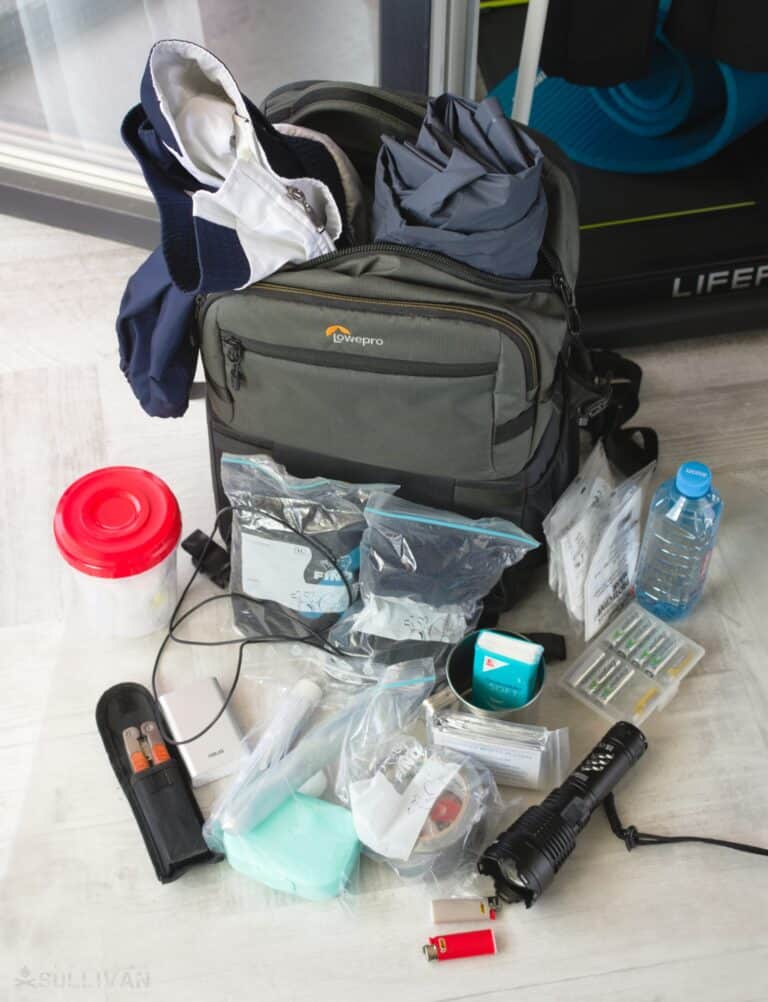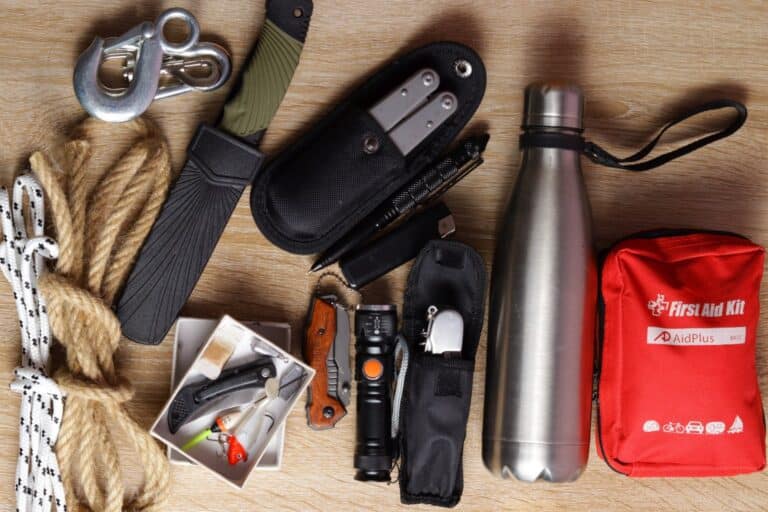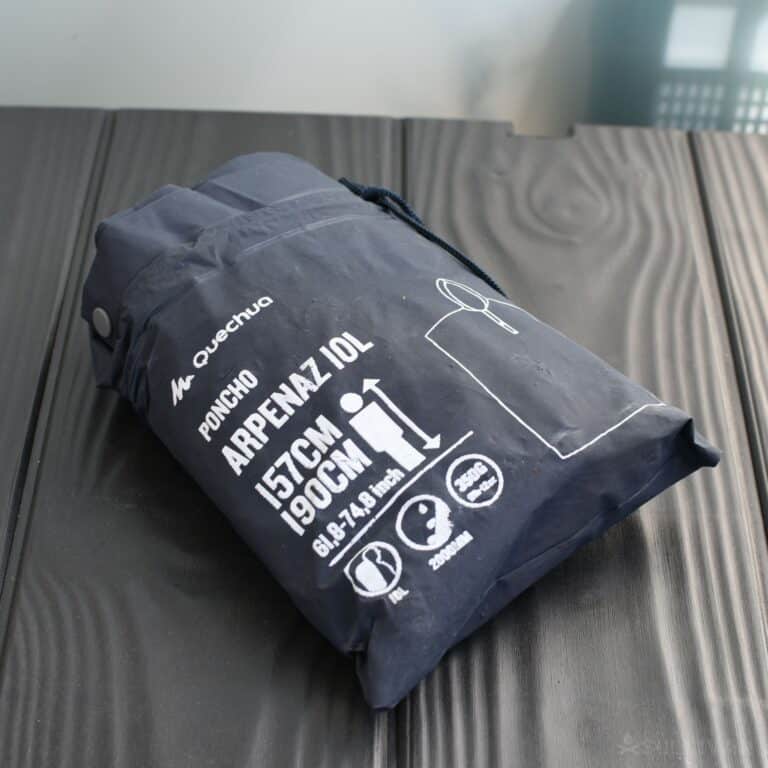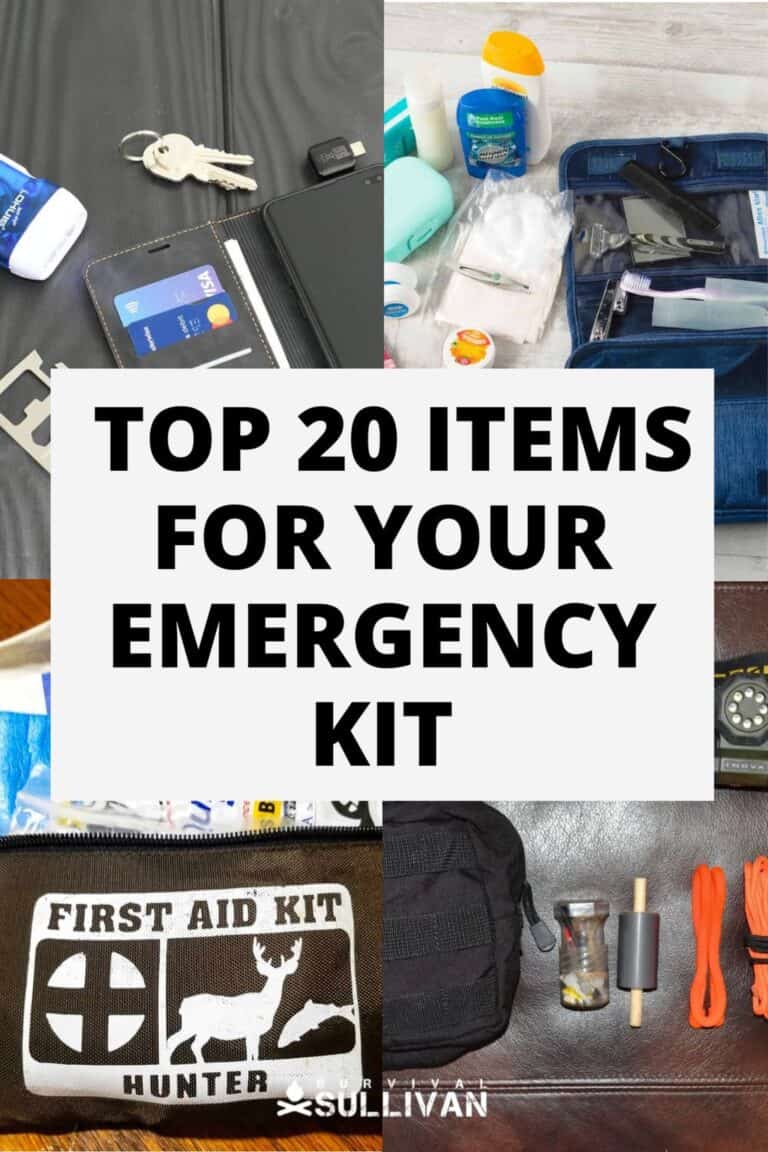Sometimes, getting the info you need to solve a problem can be demoralizing. You know what I’m talking about…

go bag backpack with clothes and survival items: flashlight, batteries, multi-tool, hygiene kit, first aid kit, external battery, poncho, duct tape and many more
If you landed on this article, you’ve probably already searched for what sorts of items should be in your survival kit. And having done that, you probably found lists with dozens, even hundreds, of different pieces of gear for every conceivable contingency.
That’s great if you’ve got a literal baggage train or a donkey to haul all your stuff, but what if you just want to be ready for a really rainy day?
Less is oftentimes more. If you want to get ready for tough times without spending a fortune and hauling dozens of pounds, you’re in the right place because I’m bringing you a list of the absolute top 20 items that should be in your emergency kit.
Water
Water is a huge concern in any and every survival scenario. Even if you’re surrounded by water, it might not be safe to drink. Having fresh, potable water on hand at the outset will go a long way towards keeping you hydrated and that means keeping you alive.
A good, sturdy water bottle containing a liter if liquid is a good start. Don’t rely on flimsy, disposable bottles because they have a tendency to leak in storage.
Water Filter
Your water supply probably won’t last longer than a day or two at most depending on your activity level, and like I said above, all of your normal water sources might be out of action or compromised.
A portable water filter will solve that problem by allowing you to drink water from questionable natural or man-made sources while eliminating dangerous germs and contaminants.
You can use a standalone water filter like a Sawyer Mini or a LifeStraw, or even get one that is integrated with your water bottle for easy filling and drinking on the go.
Food
Some folks might omit food from a light and lean survival kit like this, but don’t make that mistake. Even though you can live for weeks without any food and still not starve, your physical and mental state will be in the toilet without a regular intake of calories.
Super calorie-dense survival bars, trail mix, and things like that that provide maximum energy for minimum weight and bulk are what you should pick for this kit.
Cell Phone (w/ charger)
Don’t be a survival Luddite. Cell phones aren’t guaranteed to go down for the count as soon as a bad situation develops or a disaster happens. Cell phone networks tend to be reliable and fairly redundant, and modern smartphones have tons of useful capabilities besides.
If you don’t habitually keep your cell phone on your body, have a spare in your survival kit, keep it charged, and include a charger with wall and vehicle adapters.
Emergency Radio
A cell phone might be able to handle much of your communications and info-gathering needs in a crisis, but a little redundancy is a great idea especially in the case of a very destructive event.
An emergency radio can tune in to NOAA and FEMA broadcasts to let you keep a handle on a developing situation.
Most are powered by batteries, and good ones have a hand-cranked dynamo that can provide power forever as long as you can provide a little muscle. Some even have built-in USB charging slots to keep your phone topped off!
Flashlight
Flashlights are indispensable. End of story!
Invest in a good, rugged, and compact multipurpose flashlight for this survival kit. One that has multiple output modes to help conserve power is a plus, as is additional functionality like a strobe feature that might be able to attract attention from rescuers farther away.
You can use one that relies on disposable primary cells or has rechargeable batteries – there are pros and cons to each.
Extra Batteries or Power Bank
Between the phone, radio, and flashlight, you’ll need extra resources to keep them functional. Toss a pack or two of the appropriate batteries in your bag or keep a charged power bank with the needed cables and connectors in there for the same purpose.

various survival items: multitool, knife, first aid kit, metal water bottle, carabiner, two types of rope, fishing gear, flashlight, and a folder
Multi-Tool
One pitfall I see preppers fall into over and over again is very literally hauling an entire tool chest with them anticipating various increasingly obscure scenarios that will call for specialized tools. The problem, naturally, is that modern tools are extremely heavy.
Your best bet is to get instead a multi-tool that consolidates many useful functions into a small and portable form factor. A Leatherman, Gerber, SOG, or Swiss army knife will work fine.
While it’s true they don’t do as good a job, or as comfortably, as their full-sized counterparts, these will be able to solve the most common problems you are likely to encounter during your survival situation. At least, they can do so well enough to get you through to the other side!
Maps
Yes, you might know your way around town and even around the county like the back of your hand, and your phone, of course, has GPS, but when the chips are really down, nothing beats a paper map for finding your way around.
A map of your city, local area, and a road atlas are great things to have during times of real trouble, especially if you might have to evacuate.
I would remind readers that the landscape you knew prior to the onset of the event might be drastically changed, even scoured clean, in the aftermath. All those usual landmarks and signs you relied on could be obliterated… try to get waterproof versions of these if you can.
First-Aid Kit
No matter what has happened, you can count on having to endure various bumps, bruises, scrapes, pokes, burns, and other injuries.
A first aid kit with supplies to take care of all of these things is mandatory, but if you have the skills, you should also be prepared to deal with more substantial trauma like lacerations, penetrating injuries, severe burns, fractures, etc.
Even if you don’t have those skills, and you should so make it a priority, consider that you might run into someone who can make use of those supplies to help you or a family member. Having a first aid kit is absolutely non-negotiable if you want to be prepared, so get one!
Pill Pack
A pill pack is my generic term for your battery of medications that should be in your survival kit.
This includes over-the-counter stuff for dealing with pain, fever, nausea, diarrhea, allergies, and things like that but it should also include needed prescription medicines, of any kind, that you or family members need in order to stay healthy or survive.
Remember that medications have a definite shelf life, so you’ve got to stay on top of rotating these things for freshness like you would food. Some medicines will be useless if they are too old, others might even be dangerous!
Sanitation and Hygiene Kit
A hygiene kit combines things you need to stay fresh and clean, and also takes care of nature’s call when required. Wet wipes, hand sanitizer, heavy-duty sealable plastic bags, deodorant, toothbrush, and toothpaste will cover most of your bases.
Don’t discount the idea that you might be forced to stay in one place, and in very cramped quarters, for a length of time without accessing proper facilities. Don’t neglect the stuff for taking care of going to the bathroom!
Emergency Blankets
Emergency blankets are simply wonderful. These tiny, super lightweight foil blankets can retain up to 90% of your radiated body heat, keeping you toasty warm in nearly any condition, and doing it all without adding hardly any weight or bulk to your survival kit.
They also work wonders for fashioning an improvised shelter if you’re outdoors, and in a pinch, they can even be used to catch rainwater. These are too cheap and too useful to pass up, so make sure you get some.
Spare Clothing
Let’s face it, much of the time your clothing is going to get filthy, either with dirt, mud, and dust or, terribly, blood and other bodily fluids. Having fresh clothing to change into is important not only for morale and keeping warm but also for your mindset.
Make sure the clothes you keep in your kit are seasonally appropriate, versatile, and fit you properly. Include underwear and socks as needed.

a packed rain poncho
Rain Poncho
No matter where you live no matter what you’re doing, getting caught out in the rain is just terrible. A folding, stable rain poncho can quickly be popped out, thrown on over your clothes, and taken off to dry quickly as needed.
This isn’t just a matter of comfort: getting caught outdoors in the rain when it’s chilly can quickly sap all the heat from your body and lead to hypothermia, the last thing you can afford when it’s already a bad situation.
Gloves
You’ll be counting on your hands in a survival situation, so you must protect them. Even something a simple as moving through some thorny bushes during a bug out is enough to get your fingers to bleed. Don’t let your ego write a check that you just can’t cash!
Throwing a good pair of technical gloves or heavy-duty leather work gloves to help you deal with rubble, protect your hands while using tools for heavy work, and countless other jobs that might put them in danger.
Consider nesting a pair of the former inside the latter to have backups or spares to hand out to a friend.
N95 Mask
Considering that rubble from destroyed buildings or smoke, soot, and ash from fires is likely going to be on the wind in a host of scenarios, you should avoid breathing that stuff in if you’ve got any choice.
A high-efficiency filtration mask of some kind is compact and light enough to include in this kit, and also comes in really handy if you’re dealing with any sort of serious germ outbreak, for instance!
Plain Ol’ Cash
When you need supplies and resources desperately, or just a favor you can’t get in any other way, cash will make it happen.
Society probably won’t come apart at the seams at the first sign of trouble, but electronic forms of payment like credit cards, debit cards, online banking services, and so forth do tend to go offline at the drop of a hat, even if they come back online later. That will be a relief, but in the meantime, count on cash.
Carry as much cash as you feel comfortable with, but in a survival kit, I like to have no less than $500. Make sure you keep that fact safe, and only tell people that need to know.
Copy of IDs and Important Docs
As much as we all might dream about going full Mad Max when the balloon goes up, the reality is likely going to be much different and stay that way for the foreseeable future.
Adults have to deal with adult problems, and that means proving that you are who you say you are, and you own what you say you own.
Keep paper or electronic copies of your most important IDs and documents like mortgages, bank statements, passports, and so forth in your survival kit, but make sure that you keep it safe and secure.
I prefer to keep a small flash drive with all of those docs on there in a waterproof bag, and I encrypt the file for security in case of loss or theft.
Family, Friends & Emergency Contact Information
You might have a great memory. You might be able to depend on your phone. But what you can’t do is predict all outcomes, and that means you can’t possibly remember every phone number that you need to know when in extremis.
Have a list of all family members, friends, first responders, and other useful emergency contacts written down on waterproof paper so that you can access it when needed to get in touch with whomever.
Consider also that you might be incapacitated, maybe even dead, and one of your family members or friends might need that information to get in touch with your loved ones.

The post The Absolute Top 20 Items for Your Emergency Kit appeared first on Survival Sullivan.
By: Tom Marlowe
Title: The Absolute Top 20 Items for Your Emergency Kit
Sourced From: www.survivalsullivan.com/top-20-emergecy-items/
Published Date: Mon, 18 Mar 2024 11:00:03 +0000
------------------------
Did you miss our previous article...
https://bushcrafttips.com/bushcraft-news/vg10-vs-d2-steel-in-knives-which-is-better
 What is BushcraftSurvival SkillsToolsVideosBushcraft CampsBushcraft KitsBushcraft ProjectsPrivacy PolicyTerms And Conditions
What is BushcraftSurvival SkillsToolsVideosBushcraft CampsBushcraft KitsBushcraft ProjectsPrivacy PolicyTerms And Conditions
